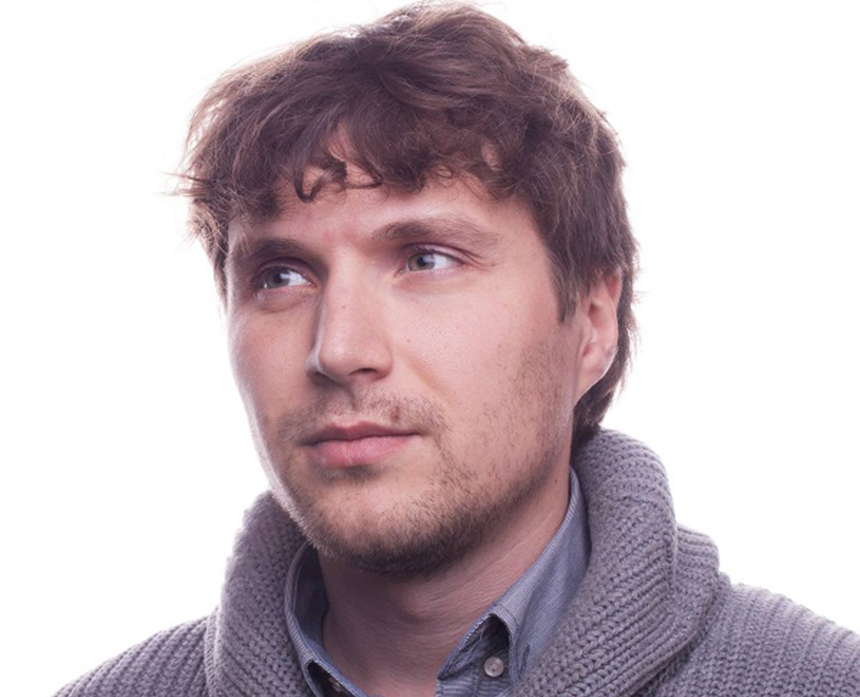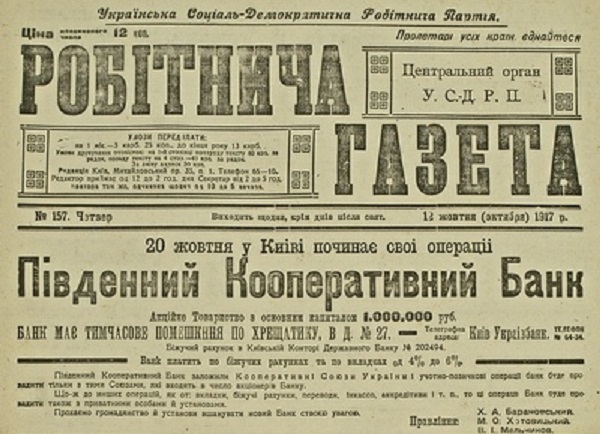Historian Serhiy Hirik: Why the UNR’s slogans were reminiscent of Bolshevik ones
[Editor’s note: In an effort to broaden the discussion of Ukrainian-Jewish interactions and relations, the Ukrainian Jewish Encounter proudly supports independent media projects. Along with Ukraine’s Hromadske Radio and Istorychna Pravda and Nash Holos in Canada, UJE this year extended support to Hadashot, which was founded in January 1991 and is one of the oldest Jewish newspapers on the territory of the former Soviet Union. Translations of select articles from the publication will appear regularly on the UJE website.]
In this interview Serhiy Hirik, Candidate of Historical Sciences and scholarly secretary of the Ukrainian Association for Jewish Studies, explains how the UNR’s [Ukrainian National Republic’s—Ed.] slogans were reminiscent of Bolshevik ones, what united Jewish and Ukrainian national communists, and how the Borotbists became the only Ukrainian national party in which Jews played a significant role.
— Serhiy, everyone is familiar with the image of the “Jewish Bolshevik.” But how strong were pro-communist sympathies in the Ukrainian milieu after the proclamation of the UNR? Did left-wing ideas find a response in the mind of the ethnic majority?
— There is no doubt, although in this case, “leftist” does not mean “Bolshevik.” Suffice it to say that the wholly leftist Ukrainian Socialist-Revolutionary Party [UPSR] possessed a majority in the Central Rada. True enough, its conciliatory policy after [Pavlo] Skoropadsky’s coup led not only to the final internal split in this party but also highlighted the fact that a considerable proportion of the masses stopped supporting the idea of Ukrainian statehood at any cost. The peasants were forced to give a significant part of their agricultural products on account of payments to Germany, which caused not just discontent but also armed uprisings that were brutally put down, in turn provoking a new wave of confrontations.
All this fertilized the soil of Bolshevik agitation, but not just Bolshevik. Practically all Ukrainian national movements in Dnipro Ukraine at the time were left-wing, and the UNR’s slogans were similar to Bolshevik ones. And it was no accident that the mouthpiece of the Central Committee of the Ukrainian Social Democratic Workers’ Labor Party (USDRP)—Symon Petliura’s party—was called Robitnycha hazeta (Workers’ Newspaper). The leaders of this party (the second most influential party in the UNR) and the Bolsheviks were Marxists, while the Directory declared at once that power in the republic should belong to the industrial classes, the bourgeoisie should definitely be stripped of its electoral rights, and Working Soviets comprised of peasants, workers, and the working intelligentsia should govern in local areas. All this was very reminiscent of Bolshevik ideas.
During this period a split takes place between the main Ukrainian parties, the majority of which had a socialist orientation. The left wing—the Borotbists who, in March 1919, rename their part of the party in the UPSR (communists)—finally break away from the UPSR and join a coalition with the Bolsheviks in May 1919.
— Around this time the Jewish population also becomes disenchanted with the UNR. Were the pogroms at fault here or was it something bigger?
— The Jewish population was simply trying to survive. Ultimately, cooperation with the Directory was the destiny of some of the leaders of Jewish socialist parties that continued to cooperate even at the onset of the pogroms.
But the majority of Jews, having become convinced that the pogroms were being severely suppressed in the territories controlled by the Reds, viewed the Bolsheviks as a lesser evil. At the same time, they were not at all in raptures over the Reds, whose policies were undermining the economic basis of small towns. As representatives of the “petty bourgeoisie,” most Jews living under the Soviets fell into the category of the disenfranchised, having forfeited a number of rights. But at the same time, they were not being attacked. Moreover, they simply did not have the time to enjoy the civil rights offered by the UNR…
— And the Jewish Communist Party (Po'ale Tsiyon) emerges in these conditions?
— Stratification takes place in all the left-wing Jewish parties. In late 1918 Po'ale Tsiyon experiences its first split, into a right wing that supported the UNR and which decamped with Petliura to Kamianets-Podilsky, and into a left wing, which remained on territory controlled by the Bolsheviks. But in the summer of 1919 even the left-wing splits, as a result of which the EKP (Po'ale Tsiyon) broke away.
This party took shape both in the Ukrainian SSR and the Russian SFSR, as well as in Soviet Belarus. In the summer of 1919, when [Anton] Denikin was advancing from the south, the leaders of the EKP retreated with the Bolsheviks and in Homiel [Belarus] held a conference of communists from Po'ale Tsiyon, thus organizationally forming a new party. The party’s Central Committee soon moved to Moscow, where the press organ of the EKP, the Russian-language newspaper Nakanune [On the Eve], began publishing.
— This was quite unusual, even for Jewish communists.
— In Moscow, where the Jewish proletariat was assimilated, the Russian language did not spark rejection in its milieu, but in Ukraine, the situation was different. Party newspapers here were published in Yiddish, and issues appearing in Russian contained the following reminder: “For technical reasons.” Agitation both in Ukraine and in Belarus also took place in the native language of the majority of local Jews: Yiddish.
— The EKP was probably the Jewish party that was the most open to cooperation.
— In Ukraine, this was manifested mainly in terms of contacts with the Borotbists. I will remind you that, having joined a coalition with the Bolsheviks, the Borotbists gained three portfolios in the government of Soviet Ukraine: the People’s Commissars of Finance, Justice, and Education.
Moreover, it was the only Ukrainian national party in which Jews played a significant role. For example, the Jew Naum Kaliuzhny (Sheitelman) was a member of the Central Committee and its de facto leader. At one time, the ranks of the Borotbists included the influential Ukrainian official literary critics Volodymyr Koriak (Volko Bliumenshtein) and Andrii Khvylia (Olinter). At the grassroots level, the percentage of Jews was also high. As a rule, these were fully Ukrainianized natives of Poltava and Chernihiv gubernias who had adopted Ukrainian pseudonyms and wrote and delivered speeches in Ukrainian.
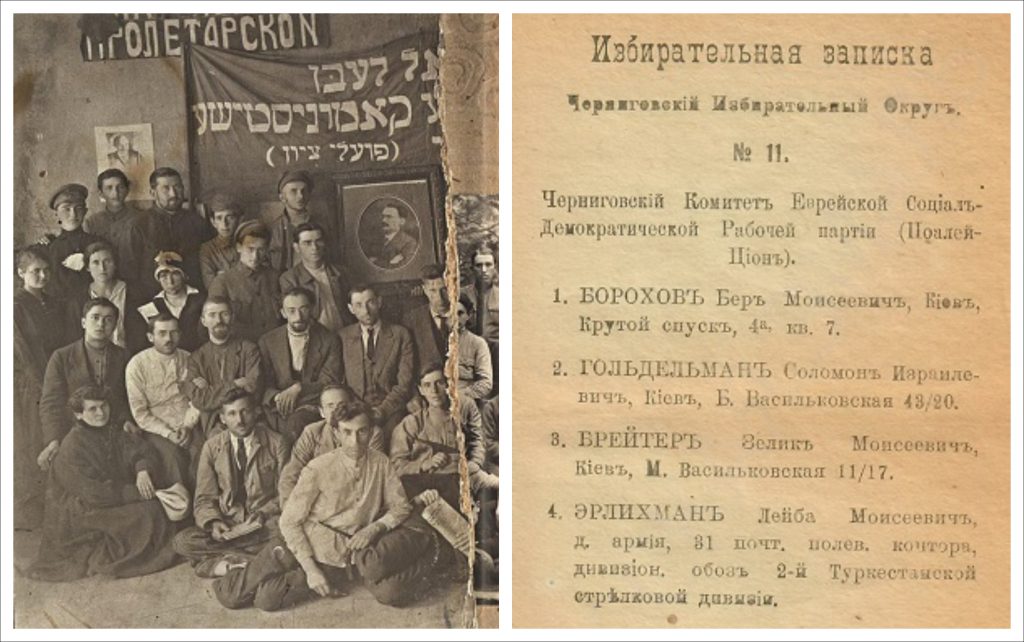
These sympathies, even taking into account their ideological closeness, are not random. The Borotbists were the only Ukrainian party that from the very beginning of the wave of pogroms called for summary executions of all pogromists and those caught carrying out pogromist agitation. Such an attitude to the pogroms was even more radical than that of the Bolsheviks.
— Why did the Jewish communists and the socialists alike oppose the formation of separate Jewish army units even during the worst days of the pogroms?
— Unlike the self-defense groups of 1905, when Jews were attacked by bandits wielding axes and pitchforks, in 1919 anti-Jewish violence often proceeded from regular army units or large partisan formations armed with machine guns and even light artillery, not to mention small arms. To come out against them with revolvers was tantamount to suicide and would have led to even greater numbers of victims among civilians. Jewish leaders were fully aware of this.
— In a resolution passed at the Homiel conference, Jewish communists raise the question of “national neglect.” How was this received by the Ukrainian national communists, for whom Ukrainianization was a fundamental ideological point?
— The EKP (Po'ale Tsiyon), following the Bolsheviks, reiterated that national discrimination was impossible under Soviet rule. But, inasmuch as it still existed, the term “national neglect” appeared, which was not perceived as anti-Soviet agitation. Jewish communists insisted that every people has its national needs. They called themselves national communists, and in the Borotbists they saw Ukrainian national communists, their natural allies.
In the UPSR(C), which renamed itself the Ukrainian Communist Party (of Borotbists; UKP[B]) in the summer of 1919, such terminology was avoided, but the party’s policy was in tune with national communism. Hence, for example, the concept of a separate Ukrainian Red Army or the demand for representation in the organs of power for the so-called rural proletariat on a par with the industrial proletariat. This was no legal casuistry, because, with equal representation for the landless peasantry, the percentage of ethnic Ukrainians in the soviets would have risen significantly. The Borotbists even called for the creation of a separate Regional Economic Soviet of Ukraine to manage the entire economy of the republic, which would coordinate all activities with the Regional Economic Soviet of the RSFSR, but without being subordinated to it. In the end, they saw Ukraine as an equal member of the future World Federation of Soviet Republics and the Third International, along with the RSFSR and other sovereign republics.
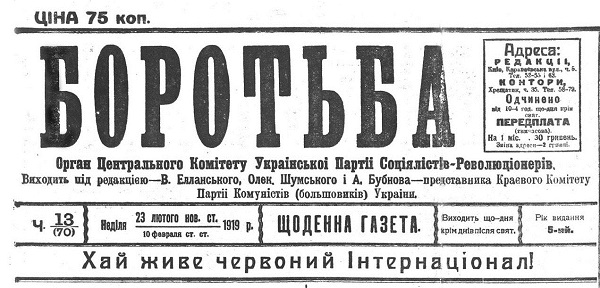
— Yes, as did the EKP (Po'ale Tsiyon), after having also submitted an application that was then refused. It is true that the Palestinian branch of the communist fraction of Po'ale Tsiyon was accepted into the Comintern as the Palestine Communist Party. Actually, the formal successor of this party is the current Communist party of Israel.
— It is telling that, unlike the Bolsheviks, nowhere do the leaders of the EKP call Zionism a reactionary doctrine, although they do suggest placing the settling of Palestine under the control of the Third International.
— First of all, the members of the EKP (Po'ale Tsiyon) remained Zionists, albeit far left ones. The party press constantly published articles on the Palestinian questions, the problems of Aliyah [the immigration of Jews from the diaspora to the Land of Israel—Trans.], etc. The EKP simply rejected repatriation “here and now,” believing that it should be preceded by the agrarianizing of the Jews, which would allow immigrants to be included in the economy of the British Mandate for Palestine. Simultaneously, talks were held about the need to create Red Legions in Eretz Israel to confront Britain. Compare this to the Borotbists’ idea of forming a Ukrainian Red Army.
In the opinion of EKP members, all this fully coexisted with Marxist theory. They claimed that the local Arab population, being predominantly agricultural, could not be proletarianized. Therefore, the Jews would become the enzyme that would revolutionize the Arab masses and prepare the ground for the proletarian revolution. Incidentally, the EKP (Po'ale Tsiyon) became the first Jewish party to open its doors to Arabs. Since Yiddish remained the leading language in the EKP, unlike in other Zionist parties, a number of Arab activists mastered this language, gave speeches occasionally in Yiddish, and published articles in it for the party press.
A similar situation emerged in the U.S., when anarchists of Anglo-Saxon background were forced to learn Yiddish, which was indispensable for work in Jewish party structures.
At the same time Jewish communists did not reject Hebrew, planning to switch to it in the distant future, but in the 1920s their party forms in Palestine were bilingual and in Ukraine—trilingual: Ukrainian, Yiddish, and Russian.
— Was the founding of the Palestine Communist Party also the work of people from the Ukrainian branches of the EKP?
— To a significant degree. One of the leaders of the Palestine Communist Party was Wolf Averbuch, who had once headed the EKP (Po'ale Tsiyon) in Ukraine. In 1922 he made Aliyah and, using the distinctive pseudonym of Abu Siam, conducted agitation among the urban Arab population. In fact, as a result of his contacts with Arab figures on the left of the political spectrum, they did not take part in the anti-Jewish riots of 1929.
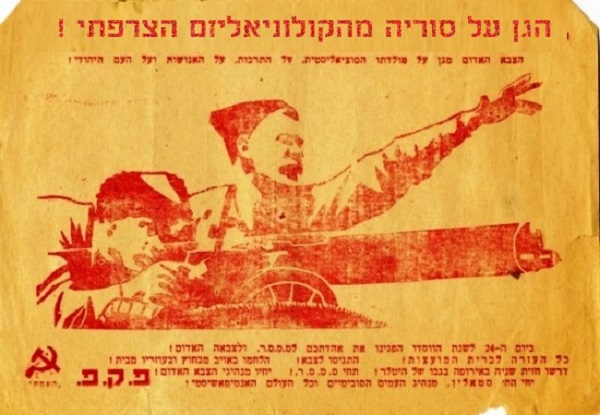
In 1930 the British expelled Averbuch for his activities to Soviet Russia, where he headed the Comintern’s Eastern Bureau, coordinating the activities of the Palestine and Egyptian communist parties. In 1935 he was transferred to the Caucasus for trade union work. A year later he was arrested; he was shot following a second trial in the summer of 1941.
— An extraordinary fate. Was the fate of other EKP leaders equally tragic?
— In the majority of cases. Averbuch’s older brother, known under the pseudonym of Aleksandr Khashin, became an essayist and literary critic. Together with [David] Ben-Gurion he edited Po'ale Tsiyon’s main press organ, the weekly newspaper Der Yidisher Kempfer [Jewish Fighter]. After the February Revolution, he lived in Odesa, fled to Berlin from the advancing Denikinites, returned to the USSR in 1924, and in Moscow edited the country’s main Jewish newspaper Der Emes [The Truth]. He was shot in 1939.
No less dramatic is the story of Zvi Friedland, the EKP leader in Belarus. In 1921 he broke with Po'ale Tsiyon on the question of why Jewish communists had to join the Bolshevik party. After completing his studies at the Institute of Red Professors in Moscow, Friedland became a specialist in the history of the French Revolution; later he wrote a biography of [Georges] Danton for the ZhZL [Lives of Extraordinary People] series, which was repeatedly reprinted. In the summer of 1934, he was appointed the first dean of the restored Faculty of History at Moscow State University. He was arrested two years later and shot in March 1937. His three great-grandsons, the Dzyadko brothers, are famous journalists in Russia: Tymofei, the former editor of Forbes; Filipp, editor in chief of the Arzamas project, and Tikhon, deputy chief editor of the RTVi television channel.
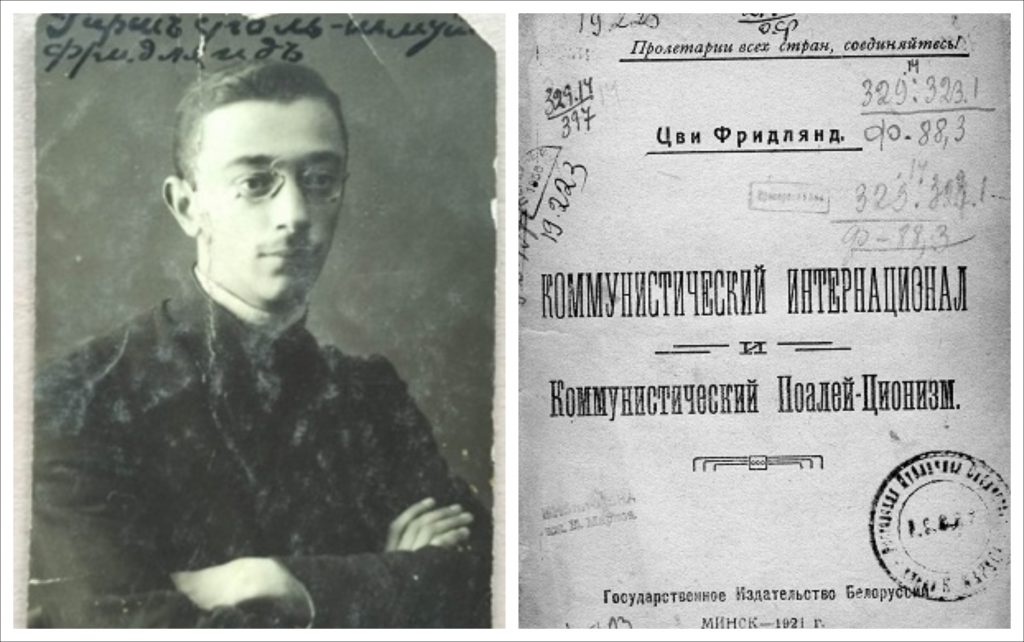
— Did the leaders of the Ukrainian national communists also perish during the Great Terror?
— Vasyl Ellan-Blakytny, the leader of the Borotbists, died a natural death in 1925, but on the whole repressions against the members of the UPSR(C) began before the Great Terror: in 1933. For example, the arrest of the poet and first chairman of the literary association VAPLITE [Free Academy of Proletarian Literature] Mykhailo Yalovy was the reason behind the suicide of Mykola Khvylovy. In 1934 the trial of the Borotbists took place, which led to the repression of a significant number of the party’s activists. Those who left Ukraine outlived their associates by several years. For example, Hryhorii Hrynko, one of the party leaders, was the former People’s Commissar of Education and the head of Gosplan Ukraine. In the 1930s he was the People’s Commissar of Finance of the USSR, whose signature appeared on all Soviet banknotes. After his arrest in 1937, a decision was made to print paper currency without anyone’s signatures because of the risk that a successor might also turn out to be an “enemy of the people.”
Some were lucky; for example, Oleksander [Alexander] Dovzhenko, who was a member of the Borotbist Party from January to April 1920; afterwards he was expelled from the CP(B)U because of this but not repressed. Others, like Oleksander Shumsky, the former People’s Commissar of Education and the ideologist of Ukrainianization, ended their days in the GULAG. The circumstances surrounding Shumsky’s death remain murky to this day. He was either poisoned in 1946 after writing a letter to Stalin from a prison hospital, or he was killed while being convoyed to Kyiv.
— Either way, did the ideology of national communism, whether the Jewish or Ukrainian variant, suffer defeat both on the personal and the conceptual level?
— This is a complicated question. Of course, most of the carriers of this ideology were repressed. But, on the other hand, thanks to the Borotbists and other national communists, the legal basis for the collapse of the USSR was laid. The Constitution of the USSR contains direct borrowings from the draft Union Treaty presented by the Borotbists back in 1919, which spelled out the formal right of withdrawal from the federal state. One of the former leaders of the Borotbists, Mykhailo Poloz, was a co-author of the Treaty on the Creation of the USSR.
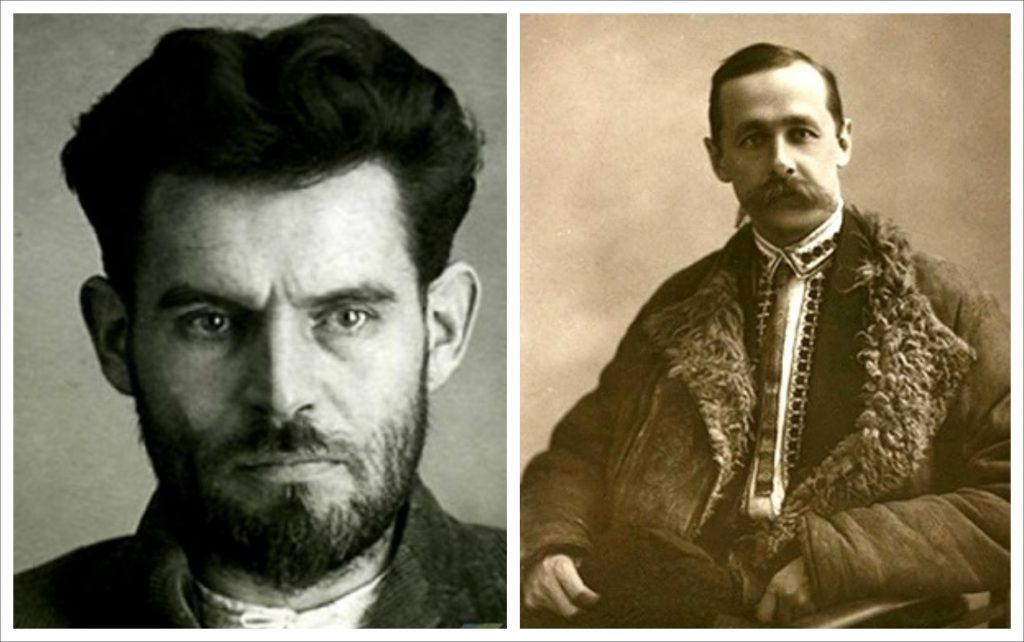
We can, of course, say that without the loyalty of the national communists, the USSR would not have come to be at all, because the Bolsheviks had no social base in the national peripheries. At the time that the agreement with the Bolsheviks was signed in 1919, the strength of the Borotbists’ guerrilla forces were almost equal to the number of Red Army troops on the territory of Ukraine. In 1920, when the UCP(B) became part of the CP(B)U, there were officially 25,000 people in the ranks of the Ukrainian Bolsheviks, and 15,000 Borotbists. And without an alliance with the Borotbists and Jewish national communists, the Bolsheviks would not have been able to gain a foothold in Ukraine. They realized this and made big concessions.
— What kind?
— From 1919 to 1927 the People's Commissariat of Education of Ukraine was headed, except for a brief period, by former Borotbists. You must understand that this People's Commissariat in fact directed all scientific, educational, cultural, and publishing activities in the republic. The entire policy of Ukrainianization was overseen by the Borotbists—ranging from schools to control over practically all literary journals. During the Literary Discussion of 1925–28, both wings were represented by former Borotbists.
The system of education founded by the Borotbists in the 1920s remained in place throughout the entire existence of the Soviet regime. Yes, there were periods of Russification, but throughout all the years of Soviet rule a significant part of the population of Ukraine obtained an education in the Ukrainian language, and this is the legacy of the Borotbists’ policy. That is why I would not talk about the complete collapse of their ideology.
The Jewish national communists present a more difficult case. Not only did their leaders, like the leaders of the UCP(B), fall victim to the Great Terror, but almost all of their social base was destroyed during the Holocaust. In the 1920s the process of Jewish colonization was no less active than the Ukrainian one. It was officially terminated in 1938, which led to the closure of Jewish schools, agricultural and pedagogical colleges, libraries, and theaters, and to the elimination of national districts and agricultural colonies. After the Second World War, by which time the Jewish population of Ukraine had decreased by two-thirds, the final blow was struck at Jewish culture. Unlike Jewish schools and literary magazines, Ukrainian schools were not closed even during the most difficult periods of persecution, which allowed for the preservation of cultural continuity after Ukraine gained independence. And a significant role in this was played by those Jews who, alongside Ukrainian national communists, were building what they thought was a new and more just Ukraine in the 1920s.
Interviewer: Mikhail Gold
Originally appeared in Russian @ Хадашот.
Translated from the Russian by Marta D. Olynyk.
Edited by Peter Bejger.
NOTE: UJE does not necessarily endorse opinions expressed in articles and other materials published on its website and social media pages. Such materials are posted to promote discussion related to Ukrainian-Jewish interactions and relations. The website and social media pages will be places of information that reflect varied viewpoints.







